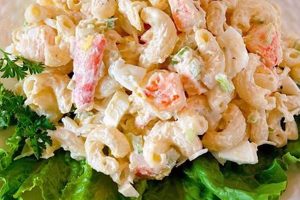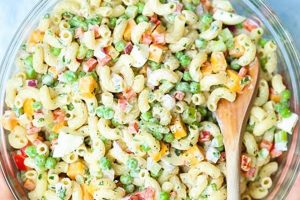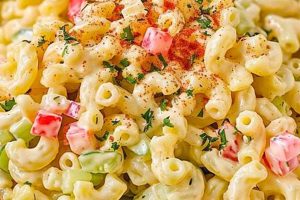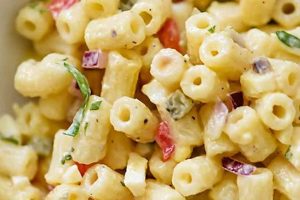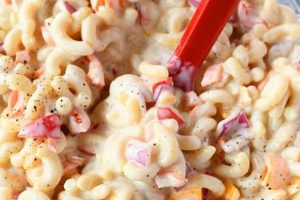This dish features cooked elbow macaroni, combined with a creamy, sweet dressing, and a variety of ingredients. Common additions include shredded chicken, sliced hotdogs, raisins, and sometimes pineapple chunks. The dressing typically consists of mayonnaise, condensed milk, and cheese, creating a rich and flavorful profile distinct from other macaroni salad variations.
This specific variation reflects Filipino culinary preferences for sweet and savory combinations, often served during festive occasions and celebrations. It represents a fusion of Western ingredients and local tastes, offering a unique cultural experience. The dishs affordability and ease of preparation also contribute to its popularity as a potluck staple and a common side dish in Filipino households.
Further exploration of this culinary tradition can include discussions on ingredient variations, preparation methods, regional differences, and its role in Filipino cuisine. Nutritional information and suggested pairings can also enhance understanding and appreciation of this dish.
Tips for Preparing Authentic Filipino-Style Macaroni Salad
Achieving the perfect balance of flavors and textures is crucial when preparing this dish. The following tips offer guidance for creating a truly authentic and enjoyable culinary experience.
Tip 1: Cook the pasta al dente. Slightly firm pasta holds its shape better in the salad and prevents a mushy texture.
Tip 2: Chill all ingredients thoroughly. Cold ingredients help maintain the salad’s freshness and prevent the dressing from becoming too thin.
Tip 3: Use quality mayonnaise and condensed milk. These ingredients form the base of the dressing; their quality directly impacts the overall flavor.
Tip 4: Balance sweetness and savoriness. Adjust the amount of condensed milk to achieve the desired level of sweetness, considering the other ingredients’ flavors.
Tip 5: Incorporate traditional ingredients. While variations exist, classic additions such as shredded chicken, hot dogs, and raisins contribute to the authentic flavor profile.
Tip 6: Add the dressing gradually. This prevents over-dressing and allows for adjustments to achieve the desired consistency.
Tip 7: Allow the salad to chill before serving. This allows the flavors to meld and enhances the overall taste experience.
By following these tips, one can create a macaroni salad that embodies the distinct flavors and textures characteristic of Filipino cuisine.
This understanding of preparation techniques enhances appreciation for the dish’s cultural significance and ensures a delicious and authentic result.
1. Sweetness
Sweetness plays a crucial role in defining the flavor profile of Filipino-style macaroni salad, differentiating it from other variations. This sweetness is primarily derived from condensed milk, a key ingredient in the dressing. The condensed milk not only adds sweetness but also contributes to the creamy texture and rich flavor characteristic of the dish. This preference for sweet and savory combinations reflects a broader trend in Filipino cuisine, where sweetness often complements savory dishes. For example, dishes like adobo, a staple in Filipino cooking, often incorporate sugar or pineapple to balance the savory flavors. Similarly, the sweetness in macaroni salad complements the savory notes of meat and cheese, creating a harmonious flavor profile.
The level of sweetness can be adjusted to personal preference, but it remains a defining characteristic of this particular variation. It contributes to the overall balance of flavors, creating a unique taste experience not found in traditional Western-style macaroni salads. The sweetness also makes the salad appealing to a wide range of palates, contributing to its popularity at gatherings and celebrations. The use of condensed milk, rather than granulated sugar, adds another layer of complexity, contributing to the creamy texture and rich flavor. In some recipes, the inclusion of fruit, such as pineapple chunks or raisins, further enhances the sweetness and adds another dimension of texture.
Understanding the role of sweetness in Filipino-style macaroni salad offers valuable insight into the cultural influences shaping its flavor profile. This distinct sweetness, derived from condensed milk and often complemented by fruits, sets it apart from other macaroni salad variations. Achieving the right balance of sweetness is essential for an authentic and enjoyable culinary experience, reflecting the unique blend of sweet and savory flavors characteristic of Filipino cuisine. Balancing the sweetness with savory ingredients is key to avoiding an overly sweet dish. This balance allows the other flavors, such as the savoriness of the meat and the tanginess of the cheese, to shine through, creating a complex and satisfying culinary experience.
2. Creaminess
Creaminess forms a cornerstone of Filipino-style macaroni salad, significantly influencing its texture and overall appeal. This characteristic texture derives primarily from mayonnaise, often combined with condensed milk. The mayonnaise provides a rich, smooth base that coats the pasta and other ingredients, binding them together and creating a cohesive dish. Condensed milk further enhances the creaminess, adding a subtle sweetness and a luxurious mouthfeel. This combination distinguishes Filipino macaroni salad from its Western counterparts, which often rely solely on mayonnaise for creaminess. The interplay of these two ingredients creates a unique textural experience, contributing to the dish’s popularity.
The desired level of creaminess can be adjusted based on personal preference and ingredient ratios. Using full-fat mayonnaise contributes to a richer, more decadent creaminess, while lower-fat options offer a lighter alternative. Similarly, the amount of condensed milk influences both the sweetness and the overall creaminess of the salad. Achieving the right balance is key to a successful dish. An overly creamy salad can be heavy and cloying, while a salad lacking creaminess can feel dry and less satisfying. The creaminess also contributes to the salad’s ability to hold its shape, preventing it from becoming watery or separating over time.
Understanding the role of creaminess in Filipino-style macaroni salad provides essential context for appreciating its unique characteristics. This creaminess, derived from the combination of mayonnaise and condensed milk, contributes significantly to the dish’s textural appeal and differentiates it from other variations. Achieving the right balance is crucial for creating a truly authentic and satisfying culinary experience. The creamy texture enhances the interplay of flavors, allowing the sweetness, savoriness, and tanginess of the various ingredients to meld harmoniously. Furthermore, the creamy texture contributes to the salad’s visual appeal, making it a more enticing dish for celebrations and gatherings. Ultimately, creaminess represents a key element in what defines Filipino-style macaroni salad and contributes to its enduring popularity.
3. Variety of Ingredients
The hallmark of Filipino-style macaroni salad lies in its diverse array of ingredients, contributing to a complex interplay of flavors and textures. This variety distinguishes it from simpler versions, reflecting resourcefulness and a preference for incorporating readily available components. Examining these ingredients provides insight into the cultural and culinary influences shaping this dish.
- Protein Elements
Protein additions typically include shredded chicken or diced hot dogs, contributing savory notes and a textural contrast to the pasta. Chicken, often poached or rotisserie, offers a leaner protein option, while hot dogs provide a distinct salty and smoky flavor reminiscent of American culinary influence. These protein elements offer a substantial element to the salad, making it a more complete and satisfying dish.
- Sweet and Fruity Components
Raisins and pineapple chunks introduce sweetness and a chewy texture, counterbalancing the savory elements. Raisins offer a concentrated sweetness and a slightly tangy note, while canned pineapple provides a tropical sweetness and a burst of juiciness. These sweet additions reflect the Filipino preference for blending sweet and savory flavors. While not universally included, these ingredients showcase regional variations and personal preferences.
- Vegetables and Relishes
Additions such as shredded carrots, chopped celery, or sweet pickle relish provide textural complexity and subtle vegetal notes. Carrots offer a mild sweetness and a satisfying crunch, while celery contributes a refreshing crispness. Sweet pickle relish adds a tangy sweetness and a contrasting texture. These elements add depth and balance to the overall flavor profile, preventing the salad from becoming overly sweet or rich.
- Binding and Flavoring Agents
Mayonnaise, condensed milk, and cheese provide the creamy base and characteristic sweetness. Mayonnaise acts as the primary binding agent, creating a cohesive texture and a rich mouthfeel. Condensed milk adds sweetness and further enhances the creamy texture. Cheese, often cheddar or quick-melt, contributes a salty, savory element and a smooth, melty texture when combined with the dressing. These ingredients form the foundation of the salad, influencing its flavor, texture, and overall appeal.
The variety of ingredients in Filipino-style macaroni salad exemplifies its adaptability and the fusion of various culinary influences. The combination of proteins, sweet elements, vegetables, and the creamy base creates a balanced and flavorful dish suitable for various occasions. This versatility and adaptability contribute to its enduring popularity as a staple in Filipino cuisine.
4. Chilled Temperature
Chilled temperature constitutes a critical element in Filipino-style macaroni salad, significantly impacting texture, flavor, and food safety. Serving this salad cold enhances the creamy texture derived from the mayonnaise and condensed milk, preventing the dressing from becoming thin or separating. Furthermore, chilling allows the diverse flavors from the various ingredientssweet, savory, and tangyto meld harmoniously, creating a more complex and balanced flavor profile. Lower temperatures also inhibit bacterial growth, crucial for food safety, particularly given the combination of ingredients and the typical preparation methods, which often involve making the salad ahead of time for gatherings and celebrations. Room temperature storage, especially in warmer climates common in the Philippines, can promote bacterial growth, posing health risks.
Consider a scenario where the salad is served at room temperature. The mayonnaise base may become oily and separate, compromising the desired creamy texture. The sweetness from the condensed milk may become overly pronounced, overshadowing the other flavors. Furthermore, the risk of bacterial growth increases significantly, potentially leading to foodborne illnesses. Conversely, a well-chilled salad maintains its creamy consistency, allows the complex flavors to shine, and minimizes food safety risks. This understanding of temperature’s role highlights its importance, not merely as a preference, but as an essential component contributing to both the sensory experience and the safe consumption of Filipino-style macaroni salad. This practice reflects cultural norms in the Philippines, where many dishes are served at room temperature due to climate and tradition. However, the inherent nature of macaroni salad, particularly its creamy dressing, necessitates a departure from this norm.
Chilling represents a crucial step, impacting both the culinary experience and food safety. Ignoring this aspect compromises the intended flavor profile and texture, potentially posing health risks. Therefore, maintaining a chilled temperature is paramount for achieving an authentic and safe culinary experience reflective of the care and attention to detail inherent in Filipino culinary traditions. This underscores the importance of food safety practices, especially in communal dining settings. The understanding of temperature’s impact extends beyond mere preference to encompass the crucial aspects of food preservation and responsible culinary practices.
5. Festive Occasions
Filipino-style macaroni salad enjoys a prominent presence during festive occasions, signifying its cultural importance beyond mere sustenance. This association stems from several factors, including the dish’s relative affordability, ease of preparation in larger quantities, and its generally appealing flavor profile that caters to a broad range of palates. Birthdays, holidays (particularly Christmas and New Year), and community gatherings frequently feature this salad as a staple on the celebratory table. Its presence contributes to a sense of shared culinary experience and reinforces communal bonds. Furthermore, the salad’s colorful presentation, often enhanced by the variety of ingredients, adds a visually appealing element to the festive spread. In this context, macaroni salad transcends its role as a simple side dish; it becomes an integral part of the celebratory tradition, representing abundance, shared joy, and the celebratory spirit of Filipino culture. Consider, for instance, a typical Filipino Christmas Noche Buena feast. Amidst the lechon, pancit, and queso de bola, macaroni salad holds its own, offering a refreshing counterpoint to the richer dishes and symbolizing the celebratory abundance.
This connection between festive occasions and Filipino-style macaroni salad has practical implications. The dish’s make-ahead nature allows hosts to prepare it in advance, reducing stress during the often-hectic preparations for large gatherings. Its transportability also makes it a popular potluck contribution, further reinforcing its communal aspect. This practicality strengthens the association between the dish and celebratory contexts. The salad’s adaptability to variations further contributes to its festive appeal. Families often personalize their macaroni salad recipes, adding ingredients or adjusting sweetness levels according to their preferences, making it a unique expression of family traditions within the broader cultural context. This personalization strengthens the emotional connection to the dish, elevating it beyond a simple recipe to a culinary embodiment of family history and shared memories. The salad’s presence on the table becomes a tangible representation of family heritage and the continuity of traditions across generations.
The association of Filipino-style macaroni salad with festive occasions underscores its significance as a cultural marker. Its presence at celebrations symbolizes communal values, abundance, and the importance of shared culinary experiences in Filipino culture. This understanding enriches the appreciation of the dish, moving beyond its ingredients and preparation to encompass its broader social and cultural meaning. The continued presence of this dish at celebrations ensures the transmission of culinary traditions and reinforces the sense of cultural identity across generations. Recognizing this connection adds another layer of depth to the enjoyment of Filipino-style macaroni salad, transforming it from a simple dish into a symbol of cultural heritage and shared experiences.
Frequently Asked Questions
This section addresses common inquiries regarding the preparation and characteristics of Filipino-style macaroni salad.
Question 1: What distinguishes Filipino-style macaroni salad from other variations?
The distinctive Filipino version incorporates condensed milk, creating a sweet and creamy dressing, often combined with ingredients like chicken, hot dogs, raisins, and pineapple, reflecting a preference for sweet and savory combinations.
Question 2: Can sugar be substituted for condensed milk?
While granulated sugar can add sweetness, condensed milk contributes significantly to the creamy texture and characteristic flavor profile; substitution alters these key attributes.
Question 3: What type of pasta is traditionally used?
Elbow macaroni is the standard choice due to its ability to hold the dressing well and its suitability for incorporating other ingredients.
Question 4: How long can the salad be stored?
Refrigeration for up to three days is recommended; beyond this, quality and food safety may be compromised.
Question 5: Can the salad be frozen?
Freezing is not recommended, as it negatively affects the texture of the mayonnaise-based dressing and other ingredients, resulting in a less desirable consistency upon thawing.
Question 6: What are common side dishes served with Filipino macaroni salad?
It frequently accompanies grilled meats, such as barbecue, and other Filipino dishes like pancit (stir-fried noodles) and lumpia (spring rolls), complementing the overall meal.
Understanding these aspects contributes to a more informed approach to preparing and appreciating this culturally significant dish.
Further exploration of regional variations and individual family recipes can deepen understanding of this dish’s versatility and enduring appeal.
Macaroni Salad Pinoy Style Recipe
Exploration of this dish reveals a complex interplay of cultural influences, culinary traditions, and practical considerations. The unique blend of sweetness from condensed milk, the creamy texture derived from mayonnaise, and the incorporation of diverse ingredients such as chicken, hot dogs, and raisins distinguish this variation from other macaroni salads. Its prominent role in festive occasions underscores its social significance, representing abundance, shared joy, and the continuity of Filipino culinary heritage. Furthermore, understanding the importance of chilled temperature for both optimal texture and food safety highlights the practical aspects of preparation and consumption.
This examination offers valuable insight into the multifaceted nature of Filipino cuisine. The dish serves as a microcosm of broader culinary trends, reflecting the fusion of local and international influences, the emphasis on communal dining, and the resourcefulness inherent in adapting recipes to available ingredients. Continued exploration of regional variations and individual family recipes promises further insights into this dish’s enduring appeal and its significance within Filipino culinary culture. This dish represents more than a simple recipe; it embodies a cultural narrative, reflecting history, tradition, and the ongoing evolution of Filipino cuisine.

